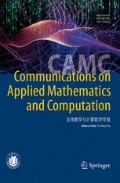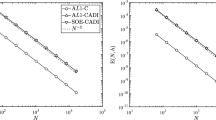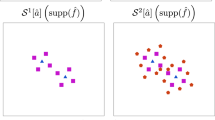Abstract
We study the convergence and asymptotic compatibility of higher order collocation methods for nonlocal operators inspired by peridynamics, a nonlocal formulation of continuum mechanics. We prove that the methods are optimally convergent with respect to the polynomial degree of the approximation. A numerical method is said to be asymptotically compatible if the sequence of approximate solutions of the nonlocal problem converges to the solution of the corresponding local problem as the horizon and the grid sizes simultaneously approach zero. We carry out a calibration process via Taylor series expansions and a scaling of the nonlocal operator via a strain energy density argument to ensure that the resulting collocation methods are asymptotically compatible. We find that, for polynomial degrees greater than or equal to two, there exists a calibration constant independent of the horizon size and the grid size such that the resulting collocation methods for the nonlocal diffusion are asymptotically compatible. We verify these findings through extensive numerical experiments.






Similar content being viewed by others
Notes
Here, the derivation is independent of the choice of the polynomial order p and the kernel function C, so we denote the calibration constant simply with \(\gamma\) rather than the pedantic notation \(\gamma _p^C\).
References
Aksoylu, B., Gazonas, G.A.: Inhomogeneous local boundary conditions in nonlocal problems. In: Proceedings of ECCOMAS2018, 6th European Conference on Computational Mechanics (ECCM 6) and 7th European Conference on Computational Fluid Dynamics (ECFD 7), 11–15 June 2018, Glasgow, UK (In press)
Aksoylu, B., Gazonas, G.A.: On nonlocal problems with inhomogeneous local boundary conditions. J. Peridyn. Nonlocal Model (In press)
Aksoylu, B., Celiker, F.: Comparison of nonlocal operators utilizing perturbation analysis. In: Karasozen, B., Manguogiu, M., Tezer-Sezgin, M., Goktepe, S. (eds.) Numerical Mathematics and Advanced Applications ENUMATH 2015. Lecture Notes in Computational Science and Engineering, vol. 112, pp. 589–606. Springer, Berlin (2016). https://doi.org/10.1007/978-3-319-39929-4_57
Aksoylu, B., Celiker, F.: Nonlocal problems with local Dirichlet and Neumann boundary conditions. J. Mech. Mater. Struct. 12(4), 425–437 (2017). https://doi.org/10.2140/jomms.2017.12.425
Aksoylu, B., Kaya, A.: Conditioning and error analysis of nonlocal problems with local boundary conditions. J. Comput. Appl. Math. 335, 1–19 (2018). https://doi.org/10.1016/j.cam.2017.11.023
Aksoylu, B., Unlu, Z.: Conditioning analysis of nonlocal integral operators in fractional Sobolev spaces. SIAM J. Numer. Anal. 52(2), 653–677 (2014). https://doi.org/10.1137/13092407X
Aksoylu, B., Beyer, H.R., Celiker, F.: Application and implementation of incorporating local boundary conditions into nonlocal problems. Numer. Funct. Anal. Optim. 38(9), 1077–1114 (2017). https://doi.org/10.1080/01630563.2017.1320674
Aksoylu, B., Beyer, H.R., Celiker, F.: Theoretical foundations of incorporating local boundary conditions into nonlocal problems. Rep. Math. Phys. 40(1), 39–71 (2017). https://doi.org/10.1016/S0034-4877(17)30061-7
Aksoylu, B., Celiker, F., Kilicer, O.: Nonlocal operators with local boundary conditions: an overview. In: Voyiadjis, G. (eds.) Handbook of Nonlocal Continuum Mechanics for Materials and Structures, pp. 1293–1330. Springer, Cham (2019). https://doi.org/10.1007/978-3-319-58729-5_34
Aksoylu, B., Celiker, F., Kilicer, O.: Nonlocal problems with local boundary conditions in higher dimensions. Adv. Comp. Math. 45(1), 453–492 (2019). https://doi.org/10.1007/s10444-018-9624-6
Atkinson, K., Han, W.: Theoretical Numerical Analysis. Springer, New York (2009)
Beyer, H.R., Aksoylu, B., Celiker, F.: On a class of nonlocal wave equations from applications. J. Math. Phys. 57(6), 062902 (2016). https://doi.org/10.1063/1.4953252
Cortazar, C., Elgueta, M., Rossi, J.D., Wolanski, N.: How to approximate the heat equation with Neumann boundary conditions by nonlocal diffusion problems. Arch. Rational Mech. Anal. 187(1), 137–156 (2008). https://doi.org/10.1007/s00205-007-0062-8
D’Elia, M., Tian, X., Yu, Y.: A physically-consistent, flexible and efficient strategy to convert local boundary conditions into nonlocal volume constraints (2019). arXiv:1906.04259 (Preprint)
Du, Q., Yang, J.: Asymptotically compatible fourier spectral approximations of nonlocal Allen–Cahn equations. SIAM J. Numer. Anal. 54(3), 1899–1919 (2016)
Du, Q., Gunzburger, M., Lehoucq, R.B., Zhou, K.: Analysis and approximation of nonlocal diffusion problems with volume constraints. SIAM Rev. 54, 667–696 (2012)
Du, Q., Lu, X.H., Lu, J., Tian, X.: A quasinonlocal coupling method for nonlocal and local diffusion models. SIAM J. Numer. Anal. 56(3), 1386–1404 (2018)
Du, Q., Ju, L., Lu, J.: A discontinuous Galerkin method for one-dimensional time-dependent nonlocal diffusion problems. Math. Comput. 88(315), 123–147 (2019)
Seleson, P., Parks, M.L.: On the role of the influence function in the peridynamic theory. Int. J. Multiscale Comput. Eng. 9(6), 689–706 (2011)
Silling, S.: Reformulation of elasticity theory for discontinuities and long-range forces. J. Mech. Phys. Solids 48, 175–209 (2000)
Silling, S.A.: Introduction to peridynamics. In: Bobaru, F., Foster, J.T., Geubelle, P.H., Silling, S.A. (eds.) Handbook of Peridynamic Modeling, Advances in Applied Mathematics, pp. 25–60. Chapman and Hall, London (2017). https://doi.org/10.1201/9781315373331
Tao, Y., Tian, X., Du, Q.: Nonlocal diffusion and peridynamic models with Neumann type constraints and their numerical approximations. Appl. Math. Comput. 305, 282–298 (2017)
Tian, X., Du, Q.: Analysis and comparison of different approximations to nonlocal diffusion and linear peridynamic equations. SIAM J. Numer. Anal. 51(6), 3458–3482 (2013)
Tian, X., Du, Q.: Asymptotically compatible schemes and applications to robust discretization of nonlocal problems. SIAM J. Numer. Anal. 52(4), 1641–1665 (2014)
Tian, H., Ju, L., Du, Q.: Nonlocal convection–diffusion problems and finite element approximations. Comput. Methods Appl. Mech. Eng. 289, 60–78 (2015)
Tian, X., Du, Q., Gunzburger, M.: Asymptotically compatible schemes for the approximation of fractional Laplacian and related nonlocal diffusion problems on bounded domains. Adv. Comput. Math. 42(6), 1363–1380 (2016)
Tian, H., Ju, L., Du, Q.: A conservative nonlocal convection–diffusion model and asymptotically compatible finite difference discretization. Comput. Methods Appl. Mech. Eng. 320, 46–67 (2017)
You, H., Lu, X., Trask, N., Yu, Y.: An asymptotically compatible approach for Neumann-type boundary condition on nonlocal problems (2019). arXiv:1908.03853 (Preprint)
Zhang, X., Wu, J., Ju, L.: An accurate and asymptotically compatible collocation scheme for nonlocal diffusion problems. Appl. Numer. Math. 133, 52–68 (2018)
Funding
Burak Aksoylu’s research was sponsored by the CCDC Army Research Laboratory and was accomplished under Cooperative Agreement Number W911NF-16-2-0008. The views and conclusions contained in this document are those of the authors and should not be interpreted as representing the official policies, either expressed or implied, of the Army Research Laboratory or the U.S. Government. The U.S. Government is authorized to reproduce and distribute reprints for Government purposes notwithstanding any copyright notation herein.
Author information
Authors and Affiliations
Corresponding author
Ethics declarations
Conflict of interest
On behalf of all authors, Burak Aksoylu states that there is no conflict of interest.
Appendix A: the case of \(p=1\)
Appendix A: the case of \(p=1\)
For \(p=1\), we provide Expansions A1 and A2 to show that one cannot find a calibration constant \(\gamma _1\) independent of \(\delta\) and h.
Expansion A1 The case of p = 1, R = 1, 3-point stencil bulk.
Due to \(p=1, R=1\), one has \({\mathcal {J}}_i := \{ i-1, i, i+1 \}\); see Fig. 7a. Obtain an explicit expression of \(A_{i,j}\) in h and define
Using Taylor series expansions,
we obtain
Expansion A2 The case of p = 1, R = 2, 5-point stencil bulk.
Due to \(R=2\), one has \({\mathcal {J}}_i := \{ i-2, \cdots , i+2 \}\); see Fig. 7b. Obtain an explicit expression of \(A_{i,j}\) in h and define
Then,
We end up with \(\gamma _1=2\) and \(\gamma _1=\frac{8}{3}\) in Expansions A1 and A2, respectively. Other expansions that we do not report here using various values of \(\delta\) and h lead to different values of \(\gamma _1\). The dependence of \(\gamma _1\) on \(\delta\) and h disqualifies the collocation method with \(p=1\) as an asymptotically compatible discretization for our governing operators \(\mathcal {M}_\mathtt{BC}\).
Rights and permissions
About this article
Cite this article
Aksoylu, B., Celiker, F. & Gazonas, G.A. Higher Order Collocation Methods for Nonlocal Problems and Their Asymptotic Compatibility. Commun. Appl. Math. Comput. 2, 261–303 (2020). https://doi.org/10.1007/s42967-019-00051-8
Received:
Revised:
Accepted:
Published:
Issue Date:
DOI: https://doi.org/10.1007/s42967-019-00051-8
Keywords
- Nonlocal operator
- Inhomogeneous local boundary condition
- Nonlocal diffusion
- Asymptotic compatibility
- Collocation method
- Peridynamics
- Functional calculus





